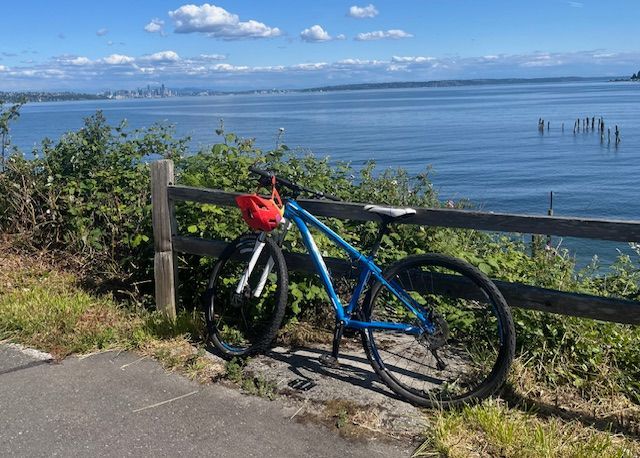The Shiny Bike: It’s Not That Good Ideas Die, It’s That They Never Get the Chance to Fully Live
(my old trusted Trek - too many miles on it to count)

Imagine a new initiative to transform human services, such as the child welfare or behavioral health system. Stakeholders are engaged. It’s crafted with care. Research supports its likely success. It’s launched and rolled out with optimism. It promises to improve outcomes for youth and families, reduce trauma, and strengthen communities. Everyone agrees, this is the change for which we’ve been waiting. This will finally solve our problems. But then, months go by. The initiative loses steam and becomes a line item in a report, a slide in a presentation, or worse, it’s forgotten altogether and replaced with a new silver bullet. A new shiny bike. Another good idea that captures attention as the next big thing to solve the problem. But, the original idea was a good one too. It’s not that it died... it’s that it never got the chance to fully live. This pattern is all too familiar in human services. Good ideas, sometimes brilliant ideas, are launched and applauded, only to fade away before they can take root. Not because they were wrong, but because the systems around them weren’t prepared to nurture and sustain them.
Complexity Isn’t Just a Buzzword
Human services operate in a world of radical complexity. We’re not just addressing individual needs; we’re intervening in the context of poverty, intergenerational trauma, under-resourced communities, historical and structural inequities and fragmented systems. These challenges don’t yield to quick fixes or silver bullets.
Leaders and policymakers, often driven by urgency and a genuine desire to improve lives and communities, design new initiatives in response. Many of them hold real promise. But they’re rarely given the time, attention, and structures needed to take hold. Instead, they’re introduced into systems that are already stretched too thin, with minimal preparation and little support for long-term implementation.
The Revolving Door Problem
A major contributor to this problem is leadership turnover. It’s been said that in most child welfare systems, the average tenure of the State Director, Secretary, or Commissioner (the most senior leaders) is between 18–24 months, with the child welfare workforce turning over 20–40% annually. That’s barely enough time to truly understand the landscape, particularly if the leader is new to the system. The workforce is just learning their jobs before they leave. If it really takes a year to solidly find your footing in a job, is there enough time, tenure, and capacity to implement, evaluate, and refine a major reform effort?
Often, new leaders bring new visions and new sets of priorities. These are often framed as a new “signature” initiative. This constant reinvention keeps organizations in a state of perpetual start-up. And while start-up energy can be invigorating, it’s not the same as sustained and disciplined implementation. In fact, the field of Implementation Science suggests that to effectively implement a system-wide evidence-based practice or initiative, it can take 3–5 years, when implementation is done well.
The Hard Work of Implementation
I’m not trying to minimize the hard work it takes to design and launch a new initiative. Conceptualization, obtaining buy-in, finding champions and advocates, securing resources, this is all hard work. But comparatively speaking, launching the initiative could be the easy part. What comes after is where the real work begins: re-aligning systems, changing daily practice, building trust (internally within organizations and externally with communities), supporting the workforce, and creating the space and processes for trial, error, learning, and adjustment. Implementation Science reminds us that lasting change happens in stages: exploration, installation, initial implementation, and full implementation. Many initiatives never move past installation, where structures are being put into place, but practice hasn’t actually changed, and ultimately, the outcomes haven’t improved. That’s why taking an implementation science-informed and capacity-building approach to systems change is essential. Steps can be taken to maximize the likelihood of implementation success, including:
- Understanding Organizational Readiness for Change: Does organizational culture, infrastructure, and workforce have both the capacity and the will to support the change?
- Balancing Model Fidelity with Adaptation Needs: How do we stay true to the model while allowing for necessary local adaptations? Implementation Science includes an array of helpful concepts and tools that can be applied in context to increase the chances of success.
- Ensuring Sustainability Planning: What steps are being taken to ensure this effort will continue? What happens if funding goes away or if champions (leaders) depart? How have we built something that can outlast a single administration?
- Creating Ongoing Learning and Improvement Through Feedback Loops: How are we listening to staff and families to continuously improve? What data are we collecting to provide meaningful insight into our progress? How is that data being used for adaptation and change?
So What Can We Do Differently?
Here are three practical steps leaders and policymakers can take to give those good ideas a fighting chance:
1. Invest in Implementation Infrastructure
Don’t just invest in start-up or pilot. Invest the time and money in building the capacity to carry it through to completion. That includes assigning dedicated staff as an implementation team to drive the effort. This team leads the workforce development strategy, identifies and obtains needed data (both numbers and stories), and uses analytical tools to understand what’s working, what’s not, and why. This team should be empowered to make changes for success and access appropriate technical assistance when needed.
2. Build the Village: Commit to Continuity Across Administrations
Create cross-agency teams (including lived and living experts) and governance structures that engage staff across all levels of the organization. This ensures there’s stability and accountability for the initiative, even when leadership changes. This approach promotes shared ownership and draws on the collective wisdom of the community. It develops champions across organizations, increasing the initiative’s chances for long-term success.
3. CQI: Routinely Measure Implementation Status and Adjust
Make implementation status and progress toward outcomes a standing agenda item in leadership and governance meetings. Ensure executive leadership (champions) are regularly briefed through a cadence of accountability meetings. Ask: What is the initiative’s current status? Is it working as intended? What barriers are emerging? How are we addressing them? What are families and staff saying?
In human services, we don’t suffer from a shortage of good ideas. We suffer from a system that doesn’t give those ideas enough time, care, and structure to grow. Let’s stop treating every initiative like a new start, and start treating them like long-term commitments to our youth and families.
Want help embedding these practices into your agency’s next initiative? Or just want to connect and brainstorm what could be and how to get there? I’d be happy to share tools and templates—just let me know. See my contact information below.
Matthew Claps Consulting, LLC
clapsmc@mac.com / 850-322-7598 / www.matthewclapsconsulting.com
